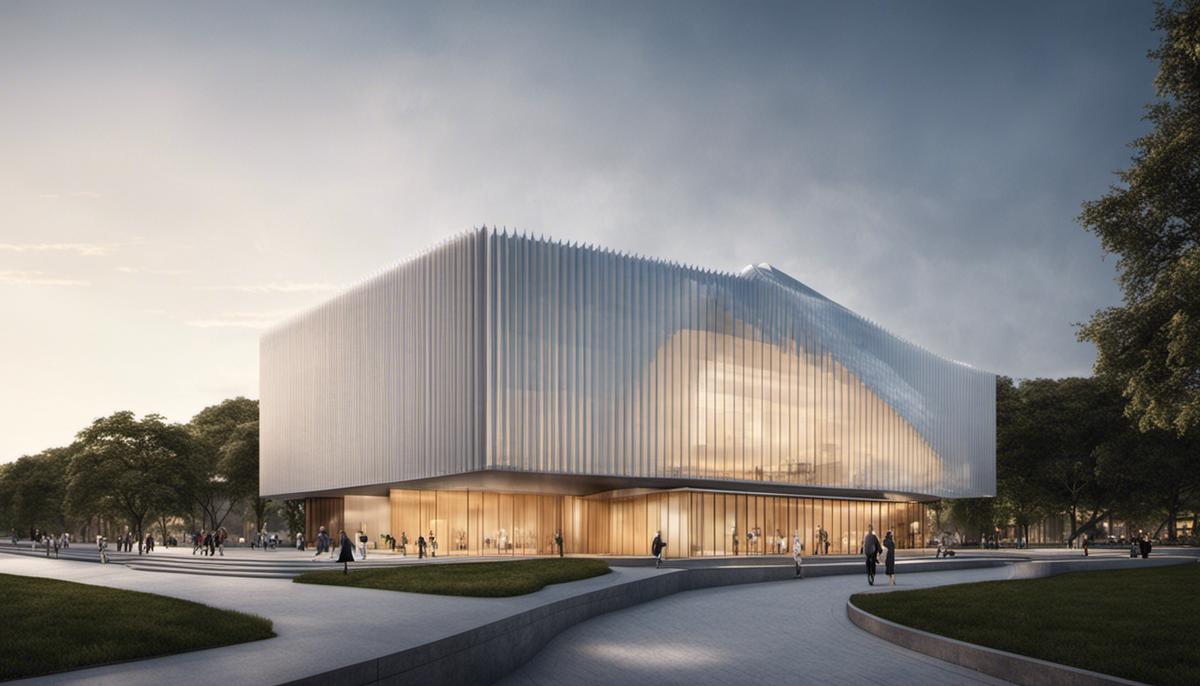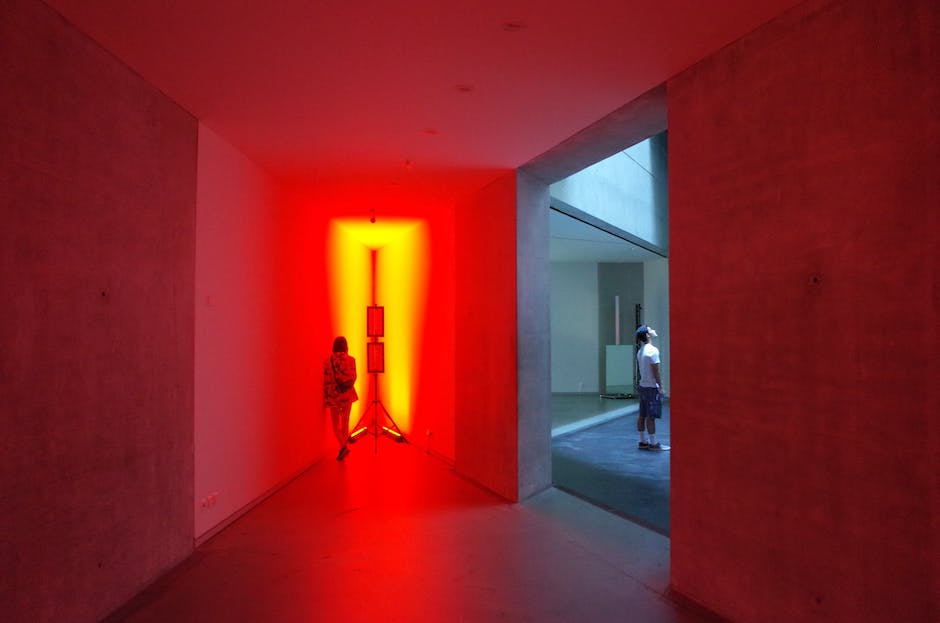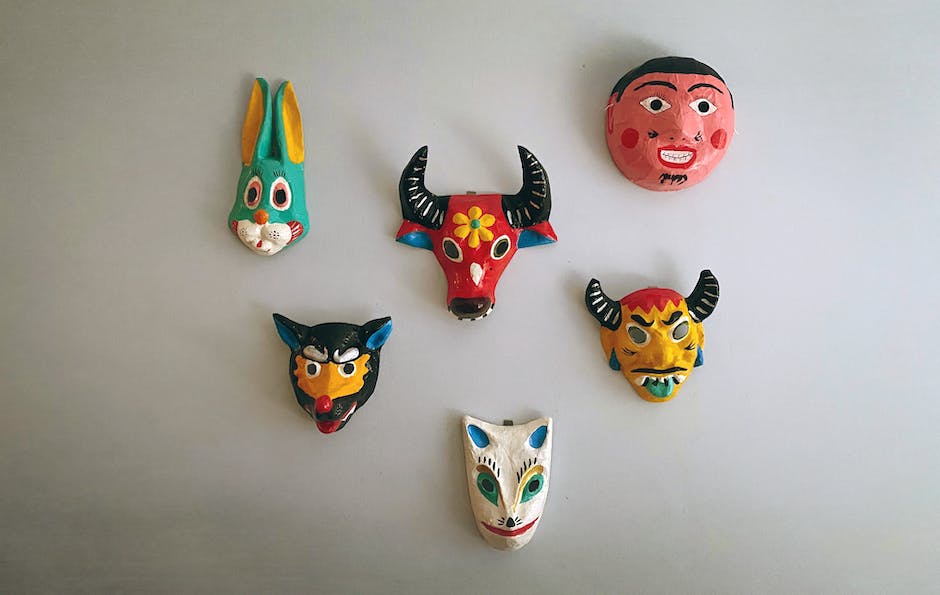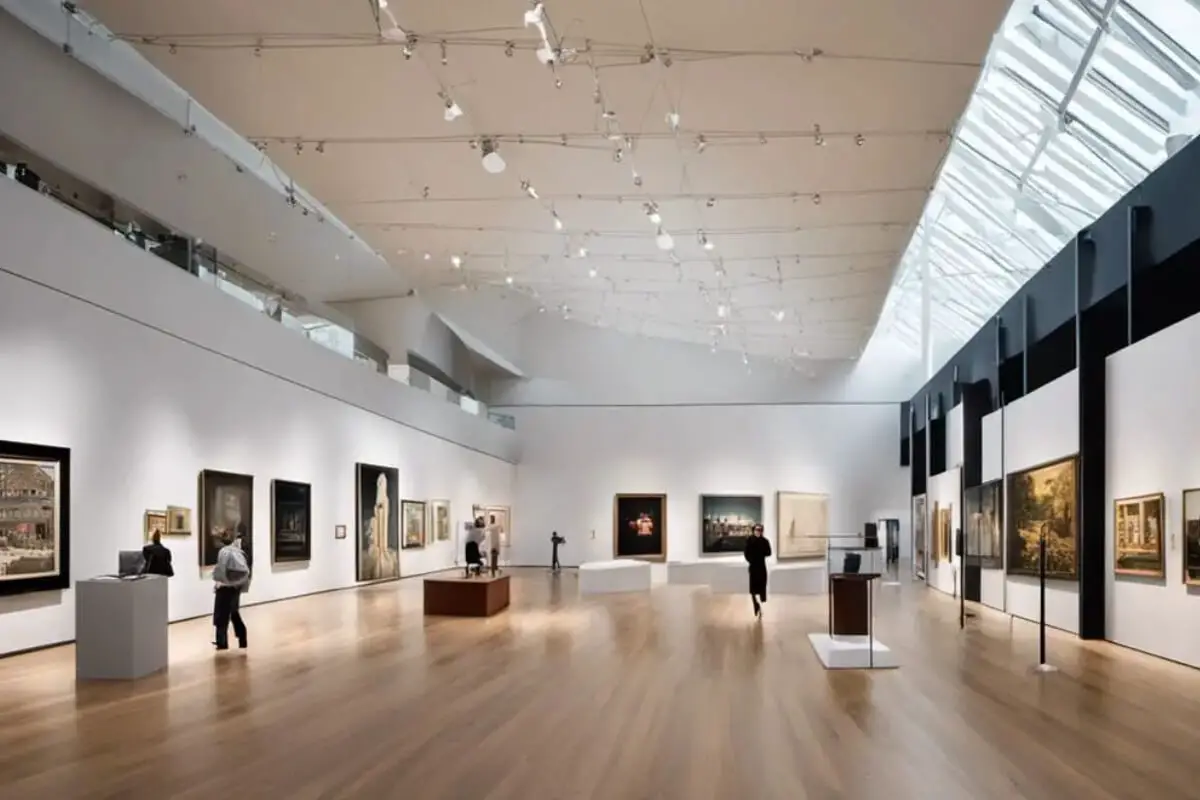The dynamic universe of contemporary art museums offers a fascinating exploration into how it speaks to societal and cultural shifts, changes in curation and displays, and the influence of numerous contemporary art movements. Tracing the historical trajectory from their nascent stages to their present incarnation, contemporary art museums are fascinating mirrors of society’s vibrant cultural zeitgeist.
Beyond their purpose of exhibition, these institutions have evolved as pivotal cultural forums affecting society’s understanding, stimulating dialogues, and fostering community development. The incorporation and representation of diverse art movements personify these museums’ vitality, extending from abstract expressionism to pop art and from conceptual art to installation art. Moreover, these museums harbor the works of artists who have left indelible imprints on the canvas of contemporary art, thereby capturing and displaying slices of living history.
Table of Contents
- Evolution of Contemporary Art Museums
- Impact of Contemporary Art Museums on Society and Culture
- Contemporary Art Movements and Their Representation in Museums
- Influential Artists in Contemporary Art Museums
- The Future of Contemporary Art Museums
- Related Questions
Evolution of Contemporary Art Museums
A Timeless Journey: The Evolution of Contemporary Art Museums
Art museums, like the pieces they house, are living, evolving entities. As embodiments of their era, they offer a fascinating window into history, culture, and the unfettered cascade of human creativity. This dynamic portrayal comes alive, especially in contemporary art museums. Over the years, they have undergone significant transformations, mirroring the shifts in society, style, and our perceptions of art.
From their inception, contemporary art museums were designed as sanctuaries that foster introspection and connection that beckon our spirits to dance in the ethereal ballet of culture.
First emerging in the late 18th and early 19th centuries, these museums took on a somewhat didactic role, enforcing a canon of ‘great art’ while educating the public about artistic milestones and movements.
However, a noticeable shift began to occur with the arrival of modernism in the mid-20th century. Contemporary art institutions started to evolve from austere homes of canonical display into lively interfacing zones where art and audience meet.
No longer simply reverential sanctuaries of high art, these museums became experimental spaces that encourage exploration and forge a dialogue between art and the viewer.
During the latter half of the 20th century, art institutions also began to echo the expanding definition of art. The focus broadened from traditional mediums like painting or sculpture to incorporate a thriving parade of video art, installation art, performance art, and conceptual art – forms that captivate the senses and tap into the nuances of contemporary human existence.
This expanding scope of what is recognized as ‘art’ has fueled the evolution of contemporary art museums into borderless landscapes of creativity.
Similarly, the role of museums as cultural archives has also evolved. Museums now position themselves as both mirrors and constructors of cultural identity, reflecting contemporary issues of society and challenging the viewer to question, consider, and understand.
This evolution calls for the inclusion of multiple perspectives, catalyzing the increasing representation of artists from different races, genders, and backgrounds.
Yet it’s not just the concept of a museum that has evolved, but its physical structure, too. The architecture of contemporary art museums often stands as a symbol of creativity, showcasing the daring and innovation as much as the artworks they safeguard.
Musehouses like The Guggenheim Museum Bilbao or The Museum of Modern Art in New York fuse the realms of art and architecture, becoming artworks themselves and embodying the ethos of their time.
Indeed, the metamorphosis of contemporary art museums reflects changes in our understanding of art, culture, and society. These institutions no longer merely preserve art but also perpetuate an ongoing conversation about its role and relevance in our lives. They prod, they challenge, they inspire, and they continue to evolve, much like the art they house, the artists they celebrate, and the audiences they serve.
In the end, one may approach contemporary art museums as a consecrated intersection where past, present, and future collide, where ideas are born, and where creativity unfurls its vibrant wings.
They are innovative platforms where art is not just displayed but also dialogued, enabling us to understand a world that is constantly in flux — an embodiment of art’s timeless journey.

Impact of Contemporary Art Museums on Society and Culture
The transformative power of contemporary art museums in the fabric of society and culture is unmistakably profound, casting a formidable influence. By transcending their traditional roles, these institutions are becoming more than just repositories of aesthetic masterpieces.
They are today, dynamic spaces operating not only as cultural fonts but also as hubs of socio-political discourse, fostering the process of shaping our society and culture like never before.
An essential attribute of contemporary art museums in today’s society is their engagement with social issues.
As purveyors of contemporary culture, they hone and display art that grapples with contemporary topics from racial injustice and gender discrimination to environmental degradation. Such art is poised to spark conversations and inspire changes, stirring a collective consciousness toward societal development.
Besides acting as a platform for social dialogues, contemporary art museums play an integral part in preserving and disseminating distinct cultural and societal narratives. This often involves promoting inclusion and diversity through the equitable exhibition of works by artists from manifold backgrounds, further broadening cultural representation.
Pandering to a diverse demographic underscores the dynamic potential of art to promote cultural literacy and empathy, encouraging mutual understanding among different societal factions.
In shaping society, contemporary art museums are equally instrumental in enhancing the creative economy. They yield considerable influence on local and even global economies, from generating employment to promoting tourism, thus fueling economic growth.
Moreover, the symbiotic relationship between art museums and creative industries continually reinforces, sparking innovations in both areas.
Perhaps the most far-reaching impact these institutions have on society and culture is through their educational programs. Contemporary art museums are significant educational resources, providing platforms for learning not only about art history and aesthetics but also about current societal issues through the lens of an artist.
These experiential learning opportunities stimulate critical thinking, fostering a more informed, sensitive, and reflective society.
Furthermore, the digital age has propelled contemporary art museums into a new realm of influence, revolutionizing their role in society. The advent of virtual exhibitions and digital archives has made art more accessible, democratizing its consumption and allowing the public to engage with art in new, interactive ways, irrespective of geographical constraints.
Incidentally, the architecture of these museums often stands as art pieces themselves, embodying the spirit of innovation and creativity they house within.
With their iconic designs, they contribute to city landscapes, often becoming symbolic of the cities they inhabit, thereby influencing urban culture.
The role of contemporary art museums in shaping society and culture, hence, cannot be overstated. With their ability to foster dialogue, promote diversity, drive economies, provide education, and leverage digital technology, these institutions, indeed, leave an indelible imprint on our collective socio-cultural identity.
Their pivot from passive galleries to active societal influencers demonstrates their restless pursuit of relevance in an ever-evolving world, further cementing their enduring significance in our lives.

Contemporary Art Movements and Their Representation in Museums
Through the lens of modernity, contemporary art museums serve as the boundaries where diverse art forms from different epochs converge, providing a distinct articulation of various art movements.
While the inception of these institutions followed a linear narrative of art history, the current expanse of their representation broadly touches upon significant movements, implicitly supporting their philosophies while ensuring each narrative is extensively explored.
Among the variety represented, Abstract Expressionism, Pop Art, Impressionism, Minimalism, and Conceptual Art prominently take the stage. The Contemporary Art Museum may display Pollock’s drip paintings to embody abstract expressionism, Warhol’s Campbell’s Soup Can exhibit pop culture, or a passive landscape of Monet that epitomizes impressionism.
Yet, beyond mere representation of these movements, museums mold the perception of these works, subtly orchestrating dialogues on the sociopolitical and cultural contexts that birthed each movement.
Moreover, with the advent and democratization of technology, museums have reconfigured their traditional method of showcasing art, significantly influencing how art movements are received.
Installations and digital art, hallmarks of tech-based Neo-Futurism art movements, are extensively employed to create immersive experiences. These advancements invoke audience engagement and inspire wider exploration of the nuance and complexity inherent in each art movement.
In essence, contemporary art museums are pivotal in not just showcasing but also preserving art across different movements. They safeguard these art chronicles against the tides of time, balancing maintaining the integrity of original pieces and making these accessible to all.
And it is within this space, at the intersection of preservation and zeal for universal inclusivity, that the essence of art – as an influencer, a symbol of resistance, and an economic catalyst – is genuinely realized.
These museums also play a critical role in increasing cultural narratives across varying geographical and societal thresholds, making them central figures in the diffusion of a creative economy.
Exhibitions and educational programs reflect this ideology, fostering experiential learning by allowing individuals to interact with and contemplate diverse art movements.
Contemporary art museums are not just architectural wonders but also cultural time capsules that preserve the aurora of various art movements. As the digital age propels us further into the future, the role of these museums continues to evolve.
Their embrace of newer forms of art, like virtual reality and digital installations, while maintaining reverence for classical movements, is telling of the journey each museum undertakes.
In conclusion, contemporary art museums are a multidimensional canvas, encompassing the myriad art movements that define human history. Their opportunity for engagement, preservation, and promotion of these diverse art movements endures as one of society’s most profound cultural gifts.
Innovative, thought-provoking, and constantly evolving, these museums underscore the dynamic nature of art, ultimately reflecting the ebb and flow of our shared human experience.

Influential Artists in Contemporary Art Museums
The contemporary art museum serves as a living shrine to creative endeavor. It contains vibrant echoes of generations past and present and is poised to shape the future. The art forms displayed within its curated spaces depict our collective narratives, struggles, triumphs, and shared human experiences.
The artists’ names often showcased are testaments to the shifting paradigms of contemporary art, and they pulse with the lifeblood of innovation.
Trailblazers such as Pablo Picasso and Marcel Duchamp tore down entrenched conventions of form and function, fostering the inclusion of abstraction and exploring the role of chance in creating art, respectively.
Jackson Pollock and Mark Rothko donned the mantle of Abstract Expressionism, aspiring to represent emotion with pure color and form. The oeuvres of these artists abound in contemporary art museums, revealing their quest to move against the current tradition and redefine art in their age.
Pop Art, a vital movement from the mid-20th century, witnessed the emergence of renowned artists like Roy Lichtenstein and Andy Warhol, who derived inspiration from popular culture, advertising, and mass media. Their artworks reside in contemporary art museums, serving as historical timelines reflecting societal shifts and the consumerist culture of the era.
Claude Monet, Pierre-Auguste Renoir, and Edgar Degas are other preeminent artists whose works find a podium within the sacred walls of contemporary art museums. Their initiation of the Impressionist movement brought a new way of visualizing the world, focusing on light, color, and momentary impressions.
Contemporary art further extends to Minimalism, credited to artists like Agnes Martin and Dan Flavin, who sought purity and simplicity in their works, reducing art to its core elements. On the other hand, Conceptual Art echoed the philosophies of artists such as Sol LeWitt and Joseph Kosuth, who proposed that the concept or idea behind the work took precedence over the finished product.
In an era brimming with technology, the sphere of art has burgeoned to include digital mediums, too. Artists like Cory Arcangel and Jeremy Bailey challenge the confines of traditional art realms with their digital installations, calling into question the relationship between art, technology, and human interaction.
Contemporary art museums are not just repositories of art; they embody the evolution of culture, mapping the ebb and flow of societal trends and ideas over time. They serve as educational platforms and incubators of creativity, fostering dialogues that transcend geographical, political, and generational barriers.
The artistry showcased within them is not only a phenomenon of visual aesthetics but also a testament to the enduring spirit and constant evolution of the human consciousness.
The artists enshrined within contemporary art museums span different eras, mediums, and ideologies. But they share a common thread – a relentless commitment to pushing boundaries, questioning norms, and unearthing new facets of the aesthetic experience.
Their art, therefore, serves as both a mirror and a whirlpool—reflecting the world around us while continuing to stir the pot of creative innovation. In essence, contemporary art museums, with the great artists they house, amalgamate our past triumphs, present realities, and future possibilities, offering a panoramic view of the human saga through the prism of art.

The Future of Contemporary Art Museums
The insatiable dynamism of contemporary art finds an exciting future in this ever-evolving arena – the contemporary art museum. The thrilling trajectory of this symbiotic relationship influences cultural landscaping, steering society’s artistic eye.
As we follow this captivating journey, a perfect fusion of past, present, and future is announced in all its radiance. The contemporary art museum is more than just a preserve; it’s an energizing pulse in the heart of our society’s creative terrain.
Embarking on the 21st century, social issues are escalated and acknowledged on a global scale, acquiring a pivotal role in shaping our collective consciousness. Contemporary art museums respond to these transformations not merely as passive groundkeepers but as active cultivators – spearheading dialogs and fostering radical thought through curation.
They influence change by aiding the creation of progressive phenomena. As distancing borders dissolve in typical global experience, contemporary art museums serve as platforms promoting inclusion and shaping diversity, offering a visual language that transgresses socio-geographical constraints.
One significant shift is the acknowledgment and exploration of the digital domain. The digital age has a profound influence on every corner of our lives, and art is no exception.
Contemporary art museums showcase the marriage of technology and art in striking visual narratives, opening us to a world where the boundaries of ‘real’ and ‘virtual’ cease to exist.
Recognizing the importance of nurturing creativity and innovative thought, contemporary art museums hold the key to a treasure trove of resources for experiential learning. They induce a vibrant spirit of exploration and foster a culture of curiosity.
As bridges between the creators and observers, the museums provide an essential backdrop for riveting dialogues.
Contemporary art museums curate and nurture a dynamic landscape of cultural diversity. They are privileged with the task of preserving this vibrant cacophony of cultural narratives.
By doing so, they allow us to delve into the minds and lives of the artists while providing a unique lens to view our humanity and society.
The architecture of contemporary art museums is another exciting aspect influencing urban culture. Morphing into cultural bulletin boards, these structures resonate with creativity and innovation.
The transformation of architecture isn’t merely symbolic but a defining feature of the museum, shaping its identity and solidifying its place in the heart of culture.
The growth trajectory of contemporary art museums echoes the never-ending evolution of artistic expression. If once museums were the caretakers of static beauty, today’s contemporary art museums are dynamic testaments holding the human spirit of exploration, questioning, and imagination.
The future of contemporary art museums lies in their capacity to adapt, evolve, and connect— to continue engaging in societal issues, preserve the past while fostering continuous explorations in contemporary art, embrace digital advancements, ensure inclusivity and diversity, and, most importantly, inspire.
Contemporary art museums stand tall, encapsulating the diverse facets of human experience, forever echoing our innate need for beauty, truth, and free expression. Drawing from the wellsprings of past and present while eagerly reaching for the future, contemporary art museums hold the pulse of human creativity in their hands, marking an unforgettable imprint on the cultural landscape.
As contemporary art museums stride forward into the future, they cater to the continuously changing social realities, technological advancements, and the tides of artistic trends. All these elements enrich a presentation to an ever-evolving and diverse audience.
Thus, these museums are neither static repositories of art nor passive observers of cultural changes. Each successive era invests itself within these spaces, thereby preserving snapshots of time through art.
And yet, the thread of evolution remains, promising a future where these museums will continue to stimulate creativity, present thought-provoking finesses of contemporary art, foster cultural interactions, and contribute to the unending discourse that art invariably invites.
Anita Louise Art is dedicated to art education, great artists, and inspiring others to find and create their art. We love art that uplifts and inspires. #ArtToMakeYouSmile! #ArtToMakeYouHappy!
If you are interested to see any of my art, you can find out more by clicking here. If you are interested in what inspires me and my paintings, you can discover more by clicking here.
We have a free newsletter and would love you to be part of our community; you can subscribe to the newsletter by clicking here. If you have any questions, I would be happy to talk to you. You can reach me, Anita, by clicking here.
Subscribe to our Anita Louise Art YouTube Channel filled with great videos and information by clicking here.
Join us for our podcast “5 Minutes With Art.” Spend just 5 minutes a week with us to discover and learn about great art and artists. You can find out more about our podcast by clicking here.
Related Questions
How Was Leonardo da Vinci Able To Master So Many Different Professions?
Leonardo da Vinci is a man known to have had many different titles and professions during his lifetime. He was able to master this profession because he was a genius. But more than just being a genius, Leonardo is also self-educating and never stops learning. He had an insatiable amount of curiosity about all kinds of subjects.
By clicking here, you can learn more by reading How Was Leonardo da Vinci Able To Master So Many Different Professions?
What Can We Learn From Leonardo Da Vinci?
Leonardo da Vinci was a philosopher; being a philosopher means that you want to seek wisdom. Leonardo was one person who tried to seek knowledge or enlightenment in his life. Leonardo was an active observer and learner of the human body, human behavior, and nature.
By clicking here, you can learn more by reading What Can We Learn From Leonardo Da Vinci?
Was Leonardo da Vinci A Philosopher?
Leonardo da Vinci was a philosopher; being a philosopher means that you want to seek wisdom. Leonardo was one person who tried to seek knowledge or enlightenment in his life. Leonardo was an active observer and learner of the human body, human behavior, and nature.
By clicking here, you can learn more by reading Was Leonardo da Vinci A Philosopher?

